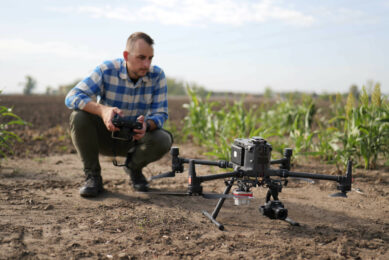Sowing cover crops with a drone: not perfect, but promising

Dutch arable farmer Pieter van Leeuwen Boomkamp sowed cover crops in his silage maize in mid-September using a drone. The idea behind this was that it might allow him to postpone chopping until after October 1st. Following Dutch law you have to sow a cover crop before ths date. By then, the cover crops, a mix of oilseed radish and leafy kale, would already be sown and germinated. Now, he looks back. What are the experiences? ‘I do want to continue experimenting.’
Sowing cover crops with a drone cannot be called a resounding success. Now that the maize has been harvested, it’s visible that the leafy kale and oilseed radish didn’t take root uniformly, and particularly the wheel tracks caused irreparable damage to the cover crops; even where it had emerged well.
Read the first part of this story: Sowing cover crops in maize with a drone
Nevertheless, Dutch arable farmer Pieter van Leeuwen Boomkamp, participant of the National Fieldlab for Precision Farming (NPPL) is interested in further experimenting. He doesn’t want to write off the system just yet. In principle, he sees the system of drone sowing late in the growing season as an alternative to sowing a cover crop earlier in the season (like reed fescue). This under-sowing had already been proven as a technique on the farm, with the contractor doing it when the maize was about knee-high. However, the problem at that time is that weed control becomes challenging; especially for controlling grassy weeds.
With this late sowing, the farmer retains more flexibility in weed control, particularly in tackling grasses. This is even more advantageous compared to under-sowing grass at the same time as sowing maize, where products based on nicosulfuron cannot be used.
Text continues below picture

According to a strict pattern
Because the farmer uses no-till farming, grass is difficult to kill off after a good development over winter. Hence, the experiment with the drone on two plots; one silage maize variety, one grain maize variety. Simply put, on September 13th, the seed mixture was flown over the plots in a strict pattern using a drone. A centrifugal spreader attached beneath the seed hopper of the drone dispersed the leafy kale and oilseed radish seeds. The soil was moist (200 mm in September). About 70 millimeters of rain fell in the week after drone sowing. In total, 300mm has fallen since sowing (13 -9), so there was no risk of drying out.
Text continues below picture

Conclusions
In early October, before chopping, researchers Thierry Stokkermans and Jos Tielen from Wageningen University Research (WUR) assessed the result of drone sowing on the two plots. Their conclusions are:
- Good germination of the cover crops.
- Also, (very) regular germinated plants in the leaf axils of maize plants. Remains small, though.
- The first plot was a silage maize variety. Due to the heavy foliage, it was quite dark at the bottom of the rows. As a result, quite feeble, elongated pale plants with white stems. Even on October 26, during a second assessment when the maize had been off for almost a week, this image of feeble plants persisted. The plot had a fairly green appearance. Pieter van Leeuwen Boomkamp thinks that in dense maize crops, it might be better to fly later. This way, there’s a greater chance that there is more light at the bottom, and the cover crop develops well. The question remains, however, what is net better for N-capture.
- Here and there a varying occupancy with cover crops, possibly due to the seeding machine maybe not dropping the same amount of seed everywhere. ‘This is probably quite simple to improve,’ says Tielen from WUR.
- The second plot had a grain maize variety. Since it was more mature and therefore more open, allowing more light at the bottom, the cover crops were stronger (greener, less stringy).
- The first plot was harvested on October 18th, in between rain showers with a lot of wetness (harvester on tracks, small dumpers (4 to 5 tons) with powered wheels as transfer wagons). In places with frequent back and forth traffic, nothing remained; even the maize stubble was no longer visible. Next year, potatoes will be planted here, which is why Van Leeuwen Boomkamp tries to preserve the soil as much as possible.
- In areas where there was no traffic: cover crops clearly visible. Plants remain quite feeble and thin, though. The question on October 26th was whether and to what extent this would improve. WUR researcher Stokkermans suggests that the used leafy kale/oilseed radish varieties apparently did not develop well in the shade. ‘Maybe another plant species or leafy kale/oilseed radish varieties are better suited for this environment.’
- Later germinated seeds, probably after chopping, received enough light and grew greener and stronger.
Text continues below video
Not a resounding success
It’s been said, the drone sowing of cover crops this year in Nijkerk was not a resounding success. However, Pieter van Leeuwen Boomkamp is still interested. With the lessons now learned, he also sees possibilities to improve the result. In any case, he wants to move away from grasses as cover crops because they are host plants for nematodes. The use of reed fescue is already better compared to the massively used Italian ryegrass, but because a much lower dosage of grass herbicide can be used in the spray mix, many types of weed grasses that are also host plants for nematodes remain. A small part of the cover crops seed ended up in moist leaf axils and germinated there.
Text continues below picture

Join 17,000+ subscribers
Subscribe to our newsletter to stay updated about all the need-to-know content in the agricultural sector, two times a week.



